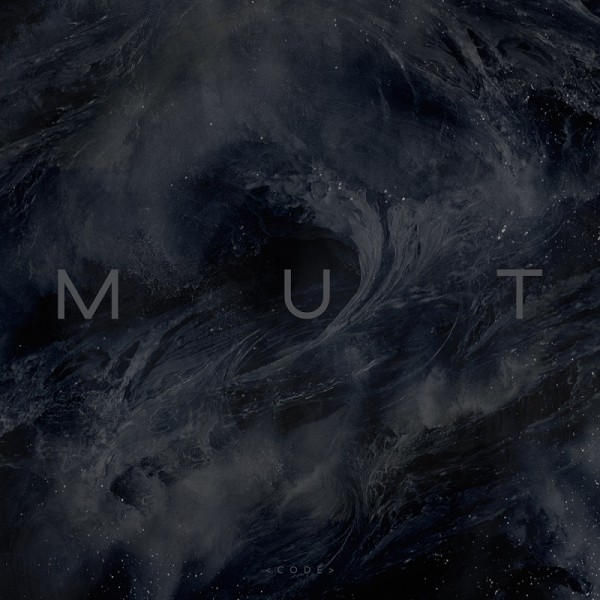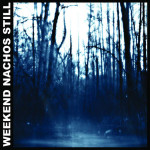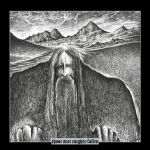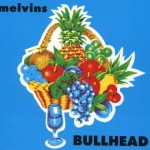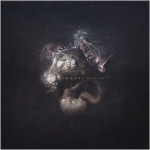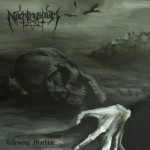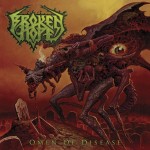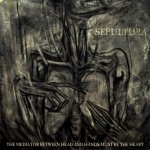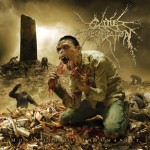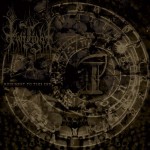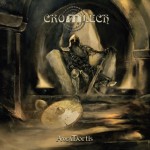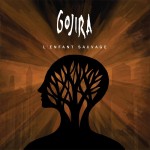Scientists have found that we learn more from our successes than our failures because of the way individual brain cells respond in real time. Like natural selection, this is a process where the winner takes all: when the idiots have run out of steam or exterminated themselves, the smart take over and breed like mad. Metal is exactly the same way. Across the world, tens of thousands of bands launch their albums at one giant egg which is the mass consciousness of metal fans, and a few make it in and become golden classics that people will talk about for decades. It’s not random; it’s about music quality. In the following reviews, we search for the 0.1% of quality in the metal world and mock the 99.9% of directionless gloop that people will talk about this week and next, and then forget.

Medusa – En Raga Sul
You know, post-metal is horsepuckey just like post-punk was. You’re making the same music with a little more dexterity and some slicker exterior. But you can’t escape the fact that your approach is the same. This circularity of doom by ignorance of abstract afflicts Medusa. These guys — normally from indie bands — can clearly play their instruments, but they understand metal on the same level as my parents. “Oh, I get it, be as loud and interruptive as possible, and random if you can.” No way, dueds. Random is an indie hipster thing. Order rising from chaos in a majestic fountain of context-expanding revelation is a metal thing. Like post-rock, post-punk, etc. this is a disappointed because they threw everything but the kitchen sink into the compositional mix, and came out with one giant average that screeches, howls, whines and cajoles like a methed-out whore. This CD will experience the wrath of Lord Bic, my lighter (and the object into which I have projected the spirit of my dead warrior ancestors).

Zebulon Pike – Intransience
This lengthy EP brings three songs in a fusion between King Crimson of the Red era and the mellower, rolling doom metal of bands like Cathedral. Thankfully, there are no vocals, which makes this quite exciting; sadly, it’s still entrenched in the “prog rock” category and does not make a metal voice out of its influences. However, it one-ups bands like Cynic or Maudlin of the Well by escaping the pop song ghetto and going for the gusto with these lengthy, prog-worshipping songs that are not so much intricately structured as they are intricate structures applied cumulatively in repetitive layers, causing a sensation of ascending a spiral staircase that changes geometric dimension at every floor. All instrumentation is straight out of 1970s King Crimson, with occasional bounding punk or doom-death metal riffs, but by the nature of keeping open harmony so it can write melodies through the chord lines in a complex fashion, there’s a lot of clanging open chords and chords formed around the upper notes of the scale, giving it a clangy old school vibe. Fans of Pelican might appreciate this fusion between indie retro aesthetic and the impetus toward topographic space savant rock epics, but if this band really wants to move forward they should forget their influences long enough to fuse a new language out of the shared heritage of rock, prog and metal that fuels this exploratory band.

Havok – Being and Nothingness
Despite the cool song titles and album concept, this is tedious metalcore: a mix of prog metal, speed metal, avantgarde punk and indie rock that uses death metal technique sometimes. Lots of heavily repetitive strumming, “groove” occurring in the midst of rhythmic chaos, and sudden breaks to “unexpected” acoustic or proggy parts in the same self-considered profundity that Opeth and Meshuggah use. Maybe you’ll like it if you like those. But then it would be an imitation of an imitation.

Woodtemple – Voices of Pagan Mountains
I am told by reliable sources that other CDs from this band are not as good. However, this one stays on my B-list of metal and will eventually be purchased. In the 2000s, buying something you’ve had kicking around on mp3 forever is a sure sign it’s destined for repeated listening. In style, this disc is like Graveland Following the Voice of Blood re-done in the style of Thousand Swords, but as if informed by early Ancient, say, Trolltaar. Longer riff-melodies and repetition interrupted by a kind of prismatic re-use and re-contexting of past riffs makes this an engrossing, labyrinthine listen. There’s some hilarious intrusions from later Bathory (Hammerheart), including experimentation with percussive riffing, but on the whole, this is a great disc and one of my favorites from post-entropy (1994) black metal, even if in style it’s a total tribute to the past.

Amesoeurs – Amesoeurs
Proving again that they’re low self-esteem losers, the vocal black metal community tripped over its own feet rushing to praise this release. I understand why; it’s easily listened to, pleasing to the air, and maintains an atmosphere that is pleasant. However, it’s shoegaze and not black metal, and deviates entirely from the moods which produce the epic experience of black metal. For sure, there are moments of storming guitar riff over blasting drums. But musically, it has little in common with black metal, and does a lot of dressing up My Bloody Valentine-style pop as something more extreme, kind of like a brainier version of Marilyn Manson. The problem with the pop approach is that it’s two-stroke: you get two emotions, mix them, and leave people with that wistful sense that something important happened and they missed it. That will not scratch the black metal itch because it’s very karmic,

Worship – Dooom
I really wanted to like this. But playing a heavy metal band this slowly crushes the ability to make riffs that are distinctive, so you end up with chord progressions you’ve heard before in a rhythm too slow to recognize; when that gets arduous, the band pause like waiting for an audience to clap along, and then resume again. And so it goes, for minutes upon minutes. It isn’t bad but it’s not necessary, and it will always gall me to have CDs sitting around that aren’t as good as the other stuff I have, but are “newer” so must be really important. It’s not. Stoner doom is the latest trend and while we all like a trend because it seems like the hand of the world has reached down to offer us an easy solution, usually this means that people adapt whatever they have to the new trend with predictable results. These songs are generic stoner doom of the heavy variety; seek Skepticism instead!

Havohej – Kembatinan Premaster
Paul Ledney makes brilliant albums every other album. You can tell from his history that he has an active mind and explores new methods of making music. Some are communicative, and so make us understand the dark mental journeys he’s taking, and others convey emptiness in a way that not only is un-informative, but also is not much fun to listen to. After all, good art is half Schopenhauer and half “Harry Potter”: it should have the profundity to twist our minds to see a greater context to our lives, but it should also be entertaining and show us our everyday struggles in a new context where we can more easily grasp what we’d rather be doing in similar situations. This latest from Havohej, like Man and Jinn before it, is an experiment in ritual rhythm music using noise instead of guitars and bass. His technique appears to be using ultrasonic noise and sublimated harmony in the drone to create additional rhythms through separation sounds (as used when tuning an instrument). The result is “interesting” academically, but horrible for listening. The sense of adventure is dead. It’s more like a mathematical proof by an interior decorator. Skip this and pick up the excellent Profanatica Profanatitas de Domonatia instead.

Greenfly – Hidden Pleasures of a Nonexistent Reality
This CD is just bad. The choice of notes is predictable; the choice of rhythms is blockheaded; the instrumentation is so competent it’s thoroughly uncreative. It’s so strikingly obvious in construction it’s hard to imagine it as something other than guitar practice that got accidentally recorded. The metalcore vocals don’t help either, nor do the recycled and completely cut-from-form speed metal riffs. If I didn’t know better, I’d say this was a parody of death metal. It’s like an angry caveman howling while he beats rocks with his club. I think the worst part is that this band seem to think they’re clever, or pure in some ironic way, for having distilled the genre into this blurting, bumbling, pounding disaster.

Hammemit – Spires Over the Burial Womb
Over the last dozen years, I have become more cynical about noise and ambient music. The reason is that there’s so much of it, yet 90% drops into the category of “goes nowhere, does nothing.” Hammemit straddles the line: a good deal of thought went into these compositions which create a ritual atmosphere of contemplation. The problem is that they do so under the conscious level, and do not form any distinct thought, only a vague impression of something sacred happening. I like that, but it’s not going to motivate people to listen to any piece of music (same problem modern and postmodern “classical” has). These collections of moans, natural phenomena noises, occasional piano and guitar, and found sounds are compelling in that they do not whack you over the head like modern material does, but they also shy away from approaching the clarity of ancient works. My suggestion to this artist is to vary the sound palette between tracks, and to aim at making the concrete form out of nothingness, as that way the mind will retain what’s afoot here.

Ihsahn – Angl
I’m going to say what others are afraid to say: this album is shit. Equal parts Cynic and Meshuggah, it shows nothing of the creativity of Ihsahm during his Emperor days; actually, it’s just a collection of well-done cliches. It’s like Nordic metal is the peak of ability in making songs, but if you feed the same crap into it, you just get a better version of that crap. I think instead we need something, like — just to pull a name out of the hat — Emperor where they made something entirely different, and as a result, were inspired to make better quality music. Repeating the past is painful. This recombines and repeats the past. I had to run across the room to hide my Emperor CDs from this dripping turd.

Demigod – Shadow Mechanics
This refreshing album eschews the pure death metal outlook for a hybrid of death metal and later Voivod-style progressive metal, using complex rhythms and multiple offsets place emphasis of protean phrases; there’s also the usual expanded chord voicings and quirky tempo changes, and while song structures are basically complex verse/chorus in the Rush model, there are enough deviations — usually about two per song — to give atmosphere and create anticipation. Smooth vocals and catchy rhythms give a nod to populism, but it’s unlikely the band thought they were authoring a best seller. It’s more likely that, like Obliveon on Nemesis or Voivod on Negatron, they were simply hoping for a more accessible canvas onto which to splash their brighter ideas, in the camouflage of being an entertainment/leisure product.

Grave – Into the Grave
After enjoying this album during the early days of Death Metal, I set it aside for about a dozen years. I don’t know why I set it aside. I know why I picked it up: I was curious to see what degree nostalgia played in my enjoyment of music, and why I seem to pathologically forget to mention this band or even think about it. Now I know: this is an album with passion, rhythmic intensity, and utterly boring selection of chords in very similar riffs and very, very similar song constructions. Musically, it’s like Asphyx played a lot faster with Slayer-esque drumming, and almost no deviation from a half-whole interval progression. They do a good job of thematic presentation, but every riff is astoundingly self-evident and without much tonal contrast. True, it’s heavy as hell, but like a bulldozer pushing rocks: after a while the dynamic is dead and you have background noise.

Corpus Christii – The Fire God
The Fire God should consume this CD. It’s entirely coherent, but aims so low that fitting together verse and chorus riffs with a bevvy of hovering keyboard trills should be easy. And it is, and that’s kind of the problem: there’s nothing here you could not find somewhere else in a more articulate form. In addition to being basically bland black metal, this CD also incorporates a lot of heavy metal elements blah blah you know the story by now. Throw in too many ingredients, and the recipe turns to mush. So does this CD. It needs a fire god to give it real passion, but for that that, it will have to pick a direction and try to find songs that can express conclusions of its own voice. Right now, it sounds like a clever recombination of things known from other sources and since I own those, well, why would I listen to this?

Demigod – Let Chaos Prevail
Most people confuse external form with content, because they assume form mirrors function. It does, but the function must come first; if there’s no clear function, we end up with an aggregate of misplaced ideas. That’s what has happened here. Demigod have tried to update their death metal sound with the “modern death metal” (read: deathcore, which is deathy metalcore) style, complete with sweeps and jazzy chugging rhythms, and the result is that they’ve adulterated their music — even while producing at the top of their musical knowledge and technical ability. In this, they are very similar to Cadaver, who did the same thing with Necrosis. The bouncy, jaunty, distraction-oriented nature of rock music and metalcore does not mix with the subtle building of atmosphere out of seemingly unrelated attributes of a stream of riffs; instead, on this CD, Demigod sound like a riff/chorus band who periodically jam on alternate riffs before going back to the safe and repetitive. Clearly they are talented, a lot like Behemoth and better than Meshuggah, but this is written in such a blockhead way that the dumbing-down traps all hopeful bits and intelligent riffs in the amber of a soon-to-be-obsolete style called metalcore.

Death Courier – Necrorgasm
What happens to innovators when the music they produce is not all that exceptional? Like Venom, this Greek band helped establish the aesthetic of death metal. Their music is not bad; it’s just boring. Moderately technical, it shows a nice grasp of basic harmony, and is probably about 50% rock music and 50% death metal. There are plenty of heavy metal riffs. There’s a clear influence on early Darkthrone, especially Goatlord, in some of the bidirectional chord progressions used in riffs. Some might point out similarities to Varathron His Majesty at the Swamp as well and not be inaccurate. But listening to this for a modern death metal listener is kind of painful.

Criterion – The Dominant
I really wanted to like this, but the riffs are too… obvious. Not much other than straightforward riffing like cutting bread, at least harmonically. Rhythmically, there’s more space, but with two glitches: their voice is derived entirely from Deicide “Once Upon the Cross” meets later Morbid Angel, and the organization of these riffs goes nowhere. Songs cycle, then end. Thud. The spirit and intent seems good behind this CD but the result is battering repetition.

Code – Resplendent Grotesque
This is really bad. It’s dramatic gothic rock pretending to be black metal, sort of a fusion between the Dimmu Borgir softer parts and Mardukish harder parts. But at the end of the day, it’s the same ranting style of vocals without much organization, recycled riffs, and lots of noise to hide where there’s no real idea. This is to be avoided if you have musical knowledge or just like quality music.

Angantyr – Haevn
I keep trying to like this band and getting halfway there. It’s very pretty; it’s very repetitive; somewhere in the middle, its direction ends up getting simplified and to my ears, not really deviating from its starting point. However, if you want to swing your willowy limbs to something pleasant and droningly melodic, this will fit the bill. Fit the bill. Fit the bill. Fit the bill.

Diaboli – Mesmerized by Darkness
Resembling Impaled Nazarene’s Ugra-Karma most in its approach, this is pneumatically-driven high speed quasi-melodic black metal with a relentless attack. Like the most extreme hardcore band you can imagine, Diaboli roar into song with verse/chorus riffing interrupted by some transitional “budget riffs” of rhythmic variations on a couple of chords. As a result, like most hardcore, it wears thin after some time. However, there are some great riffs on here and the intensity stays high. This would probably not make a great go-to album, since it lacks the kind of mystic atmosphere Forest Poetry or the aforementioned Ugra-Karma created, but it’s a good rainy day fallback.

End – III
Someone made the perfect generic black metal album: it’s rugged and rough black metal written as if it were “symphonic” metal and the keyboards got accidentally left off. Heavy metal riffs, black metal drums and vocals, sounding a lot like a cross between Absu and later Immortal if you then crossbred that with something really bouncy like Nifelheim. Even if you’re not an orthodox blackmetaller, you can see how this lack of direction leads to a very confused band who basically jam on some really basic stuff and then try to differentiate it however they can. It’s not badly done but there’s no reason to listen to it. Imagine the best SUV ever made, if you hate SUVs.

Behemoth – Evangelion
No matter what anyone says, this is deathcore or metalcore: it’s not put together like death metal. The idea behind death metal is that a string of riffs makes sense in an expanding context. This is totally cyclic, a bit of verse/chorus dressed up with some transitions, and instead of emphasizing a through-composed outlook, it directs itself toward — just like rock ‘n roll — a rhythmic chorus pattern with open chords behind it. The “carnival music” aspect of pasting together disparate riffs and layering them in keyboards to distract us is gone; these are basic heavy metal riffs done “extreme” with high BPM and lots of distortion. Vocals are masked in some odd way that makes them sound like a crowd of laryngitis sufferers demanding their change at a Burger King. It’s fair to mention that Behemoth know their basic music theory and so this holds together well as music; it’s more harmonically coherent and thus easy to listen to than most death metal. However, it conveys mostly a repetition of battering rhythm, put into the minor-key Gothic theatricism that is a kissing cousin to Marilyn Manson, which makes it more suited to the punk/rock crowd who enjoy metalcore because it’s basically rock music with prog-metal riffs.

Detournement – Screaming Response
For a minute, I was thrown back into 1994 when the fresh-voiced, power-pop-infused posi-pop-punk started hitting the shelves. Like all those bands, these guys try really hard to show both how purist punk they are, and how not punk they are, by cutting a ballad like “No Estan Solos” full of soulful appeal but ultimately pretty repetitive. The rest is surging political punk that tries to keep the outrage high but, as in the 1990s, sounded simply like the children of a post-industrial wasteland howling protests at leaders themselves in the grip of forces they cannot control. Both of these tendencies make the pandering and amateurishness come out, but other than that, there’s nothing wrong with this high-energy modern hardcore EP.

Havohej – Man and Jinn
The difference between the indefinable presence of discernible structure, natural forces and emergent properties, and the world as we experience it of visual appearance and seemingly absolute cause/effect linkages that yet are not universal, afflicts this EP both in its triumph and its failure. Its triumph is that by using sampled sounds of nuclear explosions and other droning material sounds, Paul Ledney creates a recording that sounds like avantgarde black metal without blatantly slipping into avantgarde territory. In doing so, he tweaks our noses for accepting the “air conditioner with a drumbeat” style that black metal has become; unfortunately, the failure of this CD is that it does not provide a better artistic and listening experience, only a demonstration of form. Sometimes, I wish Ledney would devote his considerable talents to writing analysis about metal instead of trying to show us sonic evidence for what only a few can perceive anyway.
No CommentsTags: Amesoeurs, Angantyr, behemoth, code, corpus christii, criterion, death courier, demigod, Detournement, Diaboli, End, grave, greenfly, havohej, Havok, ihsahn, Into the Grave, medusa, sadistic metal reviews, woodtemple, Worship, zebulon pike

